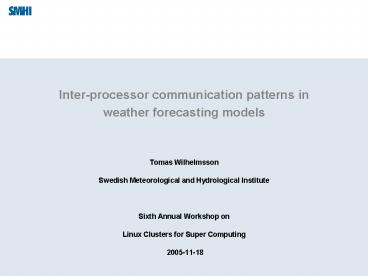Interprocessor communication patterns in weather forecasting models - PowerPoint PPT Presentation
1 / 27
Title:
Interprocessor communication patterns in weather forecasting models
Description:
Semi-Lagrangian Advection. Full cubic interpolation in 3D is 32 ... IFS & ALADIN Semi-Lagrangian advection Requesting halo points 'on-demand' Signatur ' ... – PowerPoint PPT presentation
Number of Views:38
Avg rating:3.0/5.0
Title: Interprocessor communication patterns in weather forecasting models
1
Inter-processor communication patterns inweather
forecasting models
- Tomas Wilhelmsson
- Swedish Meteorological and Hydrological Institute
- Sixth Annual Workshop on
- Linux Clusters for Super Computing
- 2005-11-18
2
Numerical Weather Prediction
- Analysis
- Obtain best estimate of current weather situation
from - Background (the last forecast 6 to 12 hours ago)
- Observations (ground, aircrafts, ships,
radiosondes, satellites) - Variational assimilation in 3D or 4D
- Most computationally expensive part
- Forecast
- Step forward in time (48 hours, 10 days, )
- Ensemble forecast
- Estimate uncertainty by running many (50-100)
forecasts from perturbed analysis
3
A 10-day ensembleforecast for Linköping
- Blue line is unperturbed high resolution
forecast - Dotted red is unperturbed reduced resolution
forecast - Bars indicate center 50 of 100 perturbed
forecasts at reduced resolution
4
HIRLAM at SMHI
- 48-hour 22 km resolution forecast on a limited
domain - Boundaries from global IFS forecast at 40km
- Also 11 km HIRLAM forecast on a smaller domain
- 40 minutes elapsed on 32 processor of a Linux
cluster - Dual Intel Xeon 3.2 GHz
- Infiniband
- More info in Torgny Faxéns talk tomorrow!
5
Codes IFS, ALADIN, HIRLAM, ALADIN
- IFS Integrated Forecast System (ECMWF)
- Global, Spectral, 2D decomposition, 4D-VAR
- ALADIN - Aire Limitée Adaptation Dynamique
développement InterNaltional - Shares code base with ARPEGE, the Météo-France
version of IFS - Limited area, Spectral, 2D decomposition, 3D-VAR
- Future AROME at 2-3 km scale
- HIRLAM High Resolution Limited Area Model
- Limited area, Finite difference, 2D decomposition
- HIRVDA HIRlam Variational Data Assimilation
- Limited area, Spectral, 1D decomposition, 3D-VAR,
(and soon 4D-VAR ? )
6
Numerics
- Longer time steps made possible by
- Semi-implicit time integration
- Advance fast linear modes implicitly and slower
non-linear modes explicitly - A Helmholtz equation has to be solved
- In HIRLAM by direct FFT tri-diagonal method
- Spectral models do it easily in Fourier space
- Implications for domain decomposition!
- Semi-Lagrangian advection
- Wide halo zones
7
How should we partition the grid?
- Example HIRLAM C22 grid (nx 306, ny 306,
nlev 40) - Many complex interactions in vertical (the
physics). - Decomposing the vertical would mean frequent
interprocessor communication. - Helmholtz solver
- FFT part prefers nondecomposed longitudes
- Tridiagonal solver prefers nondecomposed
latitudes - Similar for spectral models (IFS, ALADIN
HIRVDA) - Transforming from physical space to spectral
space means - FFTs in both longitudes and latitudes
- And physics in vertical
8
Grid partitioning in HIRLAM(Jan Boerhout, NEC)
TRI distribution
TWOD distribution
FFT distribution
Transpose
Transpose
9
Transforms and transposes in IFS / ALADIN
10
Spectral methods in limited area modelsHIRVDA /
ALADIN
- HIRVDA C22 domain
- nx ny 306
- Extension zone
- nxl nyl 360
- Spectral space
- kmax lmax 120
11
Transposes in HIRVDA (spectral HIRLAM)1D
decomposition
12
HIRVDA timings
13
Transposes with 2D partitioning
14
Load balancing in spectral space
- Isotropic representation in spectral space
requires an elliptic truncation - By accepting an unbalanced y-direction FFT,
spectral space can be load balanced
15
Number of messages
- 1D decomposition
- n4 gt 24 n64 gt 8064
- 2D decomposition
- n4 gt 24 n64 gt 2688
16
Timings on old cluster (Scali)
17
Timings on new cluster (Infiniband)
18
Zoom in
19
Minimum time on old cluster
20
FFT / Transpose timeline 2D decomposition
21
FFT / Transpose timeline 1D decomposition
22
Semi-Lagrangian Advection
- Full cubic interpolation in 3D is 32 points
(4x4x4)
23
Example The HIRLAM C22 area(306x306 grid at 22
km resolution)
- Max wind speed in jet stream 120 m/s
- Time step 600 s
- gt Distance 72 km 3.3 grid points)
- Add stencil width (2) gt nhalo 6
- With 64 processors partitioned in 8x8
- 38x38 core points per processor
- 50x50 including halo
- Halo area is 73 of core!
- But full halo is not needed everywhere!
24
IFS ALADIN Semi-Lagrangian advection
Requesting halo points on-demand
25
On-demand algorithm
- Exchange full halo for wind components (u,v w)
- Calculate departure points
- Determine halo-points needed for interpolation
- Send list of halo points to surrounding PEs
- Surrounding PEs send points requested
26
Effects on various optimizations onIFS
performance
- Moving from Fujitsu VPP (vector machine) to IBM
SP (cluster). - Figure from Debora Salmond (ECMWF).
27
Conclusion
- Meteorology and climate sciences provide plenty
of fun problems for somebody interested in
computational methods and parallelization. Also - Load balancing observations in data assimilation
- Overlapping I/O with computation































